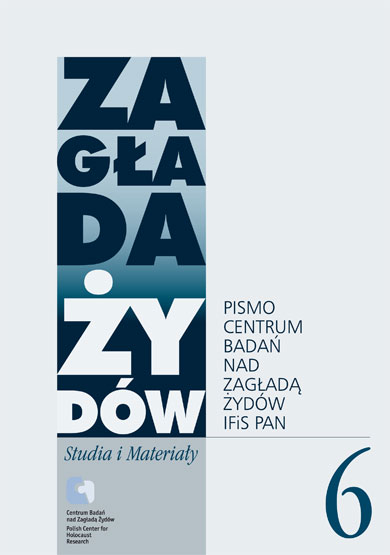„Wszystkich zabrali. Zostałam Samajedna. Bez nikogo”. Dziennik intymny Fryderyki Brück ze Stanisławowa
Zagłada Żydów. Studia i Materiały, Nr 6 (2010), Strony: 256-270
Data zgłoszenia: 2020-12-06Data publikacji: 2010-12-30
 https://doi.org/10.32927/zzsim.726
https://doi.org/10.32927/zzsim.726
Abstrakt
The article is an introduction to Fryderyka Brück’s diary covering notes from 7 May 1941 to 1 August 1942. The author of the diary came from a highly Polonized, welloff Jewish family living in Stanisławów. Her diary begins when she is only a carefree 19-year-old student with a peaceful life. The situation changes drastically after Germans have occupied the town. Fryderyka describes the first Nazi action conducted on Jews and Poles in Stanisławów when together with other representatives of the intelligentsia her father was arrested. One of the most tragic events reported in the diary is a bloody massacre of Jews in the cemetery when 10,000 Jews were killed on 12 October 1941. The notes cover the times of the move to the ghetto and life in the closed district. The girl describes the moment when on 31 March 1942 the whole of Brück family, except for Fryderyka, was taken and transported to the camp. At that
time, there is the longest gap in notes and later – the last hastily and carelessly written entry reporting chaotic events from four months. The main subject of the diary is not historical events but the relationship with Misiek Bachar. Therefore, the diary has the character of intimate notes, not intended to be read by third party. The narrative line is the emotional life, the author’s love adventures and sexual experiences. She always presents the events from the perspective of personal experience. Therefore, it might be said that it is an ordinary diary of an “average” teenager but this is what its power of message consists in nowadays. The intimacy and the specific naivety of the diary intertwines with the terror of historical events, not necessarily made conscious but also undoubtedly repressed cruelty of the Holocaust which will ultimately interrupt the author’s confessions.
Słowa kluczowe
dziennik intymny , kobiety i Zagłada , Stanisławów , getto
Licencja
Prawa autorskie (c) 2010 Autor & "Zagłada Żydów. Studia i Materiały"

Utwór dostępny jest na licencji Creative Commons Uznanie autorstwa 4.0 Międzynarodowe.
https://creativecommons.org/licenses/by/4.0
Podobne artykuły
- Justyna Majewska, Technicy „ostatecznego rozwiązania”. Topf & Söhne – konstruktorzy pieców dla Auschwitz CURIOSA , Zagłada Żydów. Studia i Materiały: Nr 13 (2017)
- Adam Puławski, Funkcjonowanie urzędu powierniczego na przykładzie Chełma , Zagłada Żydów. Studia i Materiały: Nr 13 (2017)
- Bartłomiej Krupa, Piotr Krupiński, „Dlaczego gęsi krzyczały?” Zwierzęta i Zagłada w literaturze polskiej XX i XXI wieku, Warszawa: Wydawnictwo IBL PAN, 2016, 35 6 s. , Zagłada Żydów. Studia i Materiały: Nr 13 (2017)
- Jan Tomasz Gross, Czy Zagłada jest ich historią, czy naszą? (Plaidoyer w przedmiocie ustanowienia w Polsce miejsca pamięci poświęconego Zagładzie) , Zagłada Żydów. Studia i Materiały: Nr 13 (2017)
- Marta Tomczok, Zatrucie. Piołun i popiół… trzydzieści lat później , Zagłada Żydów. Studia i Materiały: Nr 13 (2017)
- Justyna Kowalska-Leder, Dawid Sierakowiak, Dziennik , Zagłada Żydów. Studia i Materiały: Nr 13 (2017)
- Justyna Kowalska-Leder, „Coraz to nowe żądania, coraz to nowe grymasy” – relacja władzy i podporządkowania między Polakami a Żydami w kryjówkach po aryjskiej stronie , Zagłada Żydów. Studia i Materiały: Nr 12 (2016)
- Jan H. Issinger, Frankenstein w warszawskim getcie. Historia i legenda , Zagłada Żydów. Studia i Materiały: Nr 12 (2016)
- Aleksandra Bańkowska, Agnieszka Haska, „…w podziemiach wymienionych domów zakopane są…”. Poszukiwania Archiwum Ringelbluma , Zagłada Żydów. Studia i Materiały: Nr 12 (2016)
- Łukasz Biedka, Pamiętnik Cesi Gruft "W Imię Boże!" , Zagłada Żydów. Studia i Materiały: Nr 5 (2009)
<< < 4 5 6 7 8 9 10 11 12 13 14 15 16 17 18 19 20 21 22 23 24 25 26 27 28 29 30 31 32 33 34 35 36 > >>
Możesz również Rozpocznij zaawansowane wyszukiwanie podobieństw dla tego artykułu.
 English
English
 Język Polski
Język Polski








